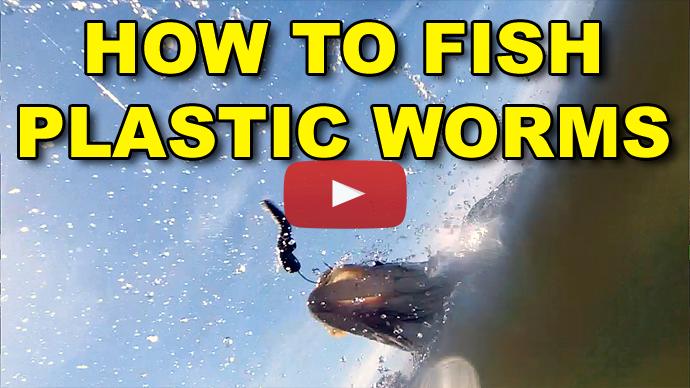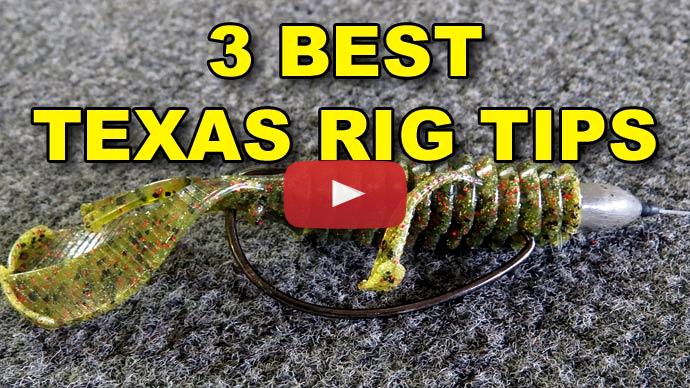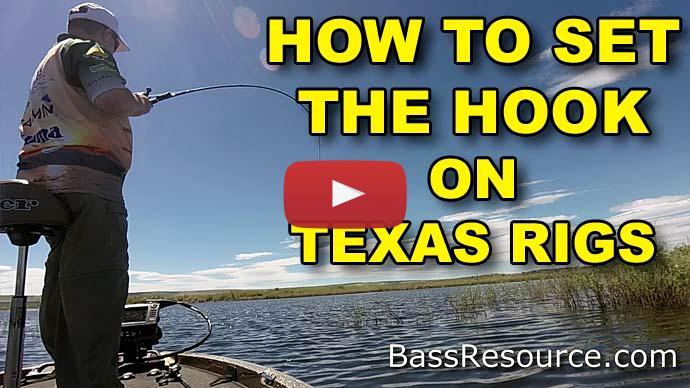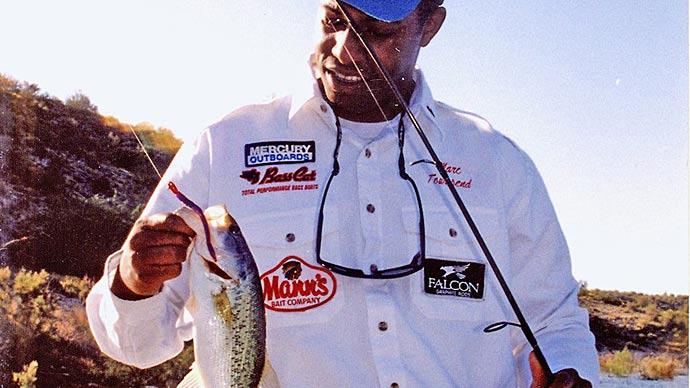Keri: Yep. There we go. This one. God, right up shallow.
Glenn: Right up where he's supposed to be. That was textbook. All right, buddy.
Keri: You need it. He won't come in.
Glenn: Come here. It's showtime.
Keri: It is. Nice one. Power-Pole's down, and showtime.
Glenn: Gotta put the Power-Poles down before I go in the bushes.
Keri: Nice one. Nice little fatty.
Glenn: Yeah. They're a...big old worm. That's funny, guys, how these worms...you wouldn't think a big worm like that a fish would go after it, but...works. Summertime fishing with big worms. That's the ticket, guys.
Hey, folks, Glenn May here with BassResource.com. And today, I wanna talk to you about fishing big worms. We're talking 10-inch worms or bigger, such as this Rage Tail Thumper right here. This is a 10-inch worm. Nice big one here. You know, a lot of people don't fish these worms. And it's funny, you know, the theory is, big bait, big fish, right? So, you would think you'd only catch big fish with this. Well, if you're fishing tournaments or if you wanna have fun fishing, that means you're not gonna catch a lot of fish. You know, numbers wise, but you might catch a few big ones. The truth is, that's a misconception.
Keri: There we go.
That might have been the one you had. He just spit up something. Just a little guy, but even the little guys love these big worms. Isn't that cool? Isn't that cool?
Glenn: Almost about as long as him.
Keri: Yeah, it is.
Glenn: You got him good.
Keri: Yeah, I did. He wasn't going nowhere. Go play. Go play.
Glenn: These baits, I've caught a lot of two and three-pounders with this. It's funny because I'll be fishing, say, for example, a tournament, and not getting a whole lot of bites. And I'll switch to a bigger bait like this and get more bites. It's something the fish don't see very often. So, don't buy into that misconception you'll get less bites but only bigger fish. I've caught big fish on this as well, but you'll catch numbers as well. It's something to do, especially when you're in a tournament situation. You want to try something different. Instead of downsizing, try going up. You might catch more fish.
This throws out a nice vibration. Big baits like this throw out a lot of vibration. Makes it easier for the fish to find, especially if you're throwing in a little bit dingy or muddy water. It has a nice big profile.
I found that these work, for the most part, during the warmer parts of the year. So, spring through fall. Not so much during the winter time. The bass just aren't really...go after something this big, at least in my experience. But in the warmer months, it can be killer.
So, let me talk to you a little bit about the rigs that I'm using, what kind of...you know, the rods and the line, all that stuff. And then, I'm gonna show you how to fish it. So, let's start off with the rod. Here is a medium heavy power rod, seven-foot, with a fast action on it. Fast action.
This is sort of your Swiss Army knife of fishing. It's your Leatherman tool, if you will. Every angler, every bass angler should have one of these in his rod locker, if not more. I've got at least four. It's a universal rod you can use for all kinds of fishing, but it's best suited for worm fishing. So, the first thing you might notice is if you've done other types of worm fishing and you have this seven-foot medium, heavy fast tip rod, you don't have to get a different rod to fish bigger baits. You don't have to do anything different. This rod works just perfectly fine.
Paired with it is a, you know, baitcasting reel. High speed reels is not really an issue when you're fishing worms, so you don't need to spend the extra money to get an eight-to-one, nine-to-one reel. If you're looking to buy a new reel for worm fishing, if you already have one of those reels, that'll work just fine. You don't have to run out and get a different reel for it, but if you're looking to buy a new reel, looking to match the equipment just right, anything over, I'd say, a six-one-to-gear ratio to like a seven-five, that's suitable for worm fishing. You're not gonna be speed reeling this, so you don't need a high speed reel.
The kind of line I use...I like to use 15-pound copolymer line, and there's a specific reason for that. First of all, I've been using copolymer line for 30-something years now. It's a universal line. Fishing from heavy cover to light cover. This covers most situations. If you plan on fishing a lot of heavy cover, a lot of flooded bush, timber, that sort of thing, braid's your answer there. And you wanna heavy up a little bit more, say at least 25 pound, if not more. Some guys like to go 65. I think it's a big heavy, but you can use fluorocarbon if you want.
Keri: There ya go! Awesome! Whoa, in the boat.
Glenn: I don't use fluorocarbon a lot when it comes to worm fishing. I do in some specific situations, especially when the water's really clear. I do like the sensitivity of fluorocarbon. But for a good all-purpose around type line, it's called copolymer or mono.
Keri: Beautiful fish.
Glenn: Braid is not a good all purpose line, because if you're fishing in rocks, braid tends to fray and get tore up in rocks. And copolymer or fluorocarbon line tends to last longer, doesn't get as nicked as much in rocks. So, that's why I use that as universal line, rather than braid. Now, tied with it here, I've a got a 3/0 hook, a 3/0 wide gap hook, extra wide gap hook. See that? Now, you would think a big bait, you should be using 6/0 hooks or 5/0 hooks, something big, because look at the size of this bait. You know, in fishing this, I've discovered that using a 6/0 hook actually got less bites. And I started to downsize and I got to about a 3/0 and I got more bites.
I don't know if that's because it lets the worm move more or what the difference is, I can't tell you, but I do know that downsizing it a bit, I get more bites. I catch more fish that way. Granted, on a big bait like this, you're gonna have fish grab the tail, and a 6/0 hook isn't gonna help you there anyway. Sometimes fish grab the tail, you set the hook, and you lose them. That's just how it is with bigger baits. They don't always get it all...they don't always hit the front. Most of the time they hit the front, they're gonna get that big hook in their mouth. That's a good 3/0 hook and it's gonna work just fine with you.
Paired with it, I've got a 3/8th Tungsten Weight, Tungsten Bullet Weight. I go a 1/4 ounce to 3/8’s to start off with. Typically, that'll work for most scenarios. I've fished in a little bit of heavier cover today. I'm having a little difficult to get into penetrating it, so I went a little up. I typically...quarter ounce is where I start. And then start adding more weight as I need to, to make sure I penetrate that cover. I don't wanna have a real fast drop. The slower the drop, the better. So, I go as light as I can get away with.
I also use a bobber stop. A little bobber stop. I don't know if you could see that, but here's a little bobber stop right there to help peg the weight. See, it's pretty...there you go. Peg the weight to the worm.
Now, the last thing I do, it's a little trick I'd like to show you guys. So, I take 40-pound monofilament line, real wiry stuff, and just get a big spool of that. Get that at a bargain bin somewhere at your tackle store. What I like to do is I'll take it and I peg it right through. Now I got the eye of the hook embedded in the worm. So, what I'll do is I'll take this line and I'll peg it right through the eye of that hook. Just like so. All right? Now, what that does, it holds this worm to this hook. Prevents it from sliding down when I set the hook. Just like that. All right? It's in there good and solid.
So now, I'm just gonna show you, I'm moving it here. Look at this. See how I'm pulling on it. See that? It's not coming down the hook. Nice, huh? So, when you set the hook, it doesn't ball up around the hook point. It doesn't slide down, and because it's not getting slide...you know, a lot of times the worms, they get all tore up here. That prevents them from getting tore up, so it makes it last longer. Nice little tip, huh? Cheap. Effective.
For the knot I use, it's just a uni knot. I use the uni knot because I've been doing that for 35 years. I've never had a knot fail on me. If you're comfortable using a polymer knot, that's fine too. I know some of you guys like to use a San Diego jam knot. That's equally as effective.
My preference is a uni knot, just because I learned it so long ago and I've never had a problem with it. I've done head-to-head testing with the uni knot, San Diego jam knot, and the polymer knot, and they're all pretty equal. There's not much of a difference between in terms of holding strength. So using those knots, you'll be perfectly fine with this.
So, there's your setup. There's your rod reel. That's how I rig it. Now let's go out and fish it.
Come here, you. You don't think these...even the smaller fish could...look at the size of this worm. Look at this thing. You don't think these guys will eat this worm. Boy, he got it. He ate it. It worked. You'll catch all sizes of fish with these worms. Let's see if we can catch some bigger ones. Geez, Louise. There.
All right, to fish this big old worm, what I like to do...I like to pitch. That's just my favorite way of getting in to cover like this. You can cast or you can flip if you want. I just prefer to pitch. Whatcha wanna do on this is just pitch it in there and let it sink. The first cast I wanna show you, the first retrieve, just let it fall all the way, reel down with it so you're following the line, and then let it hit the bottom. Watch as it's falling. That's the most critical thing.
A lot of times what happens is when you are...when you're doing that, when the lot...when the lure is falling, that's when the fish hits. So, that's the most critical time to watch. Just watch that and reel down with the line. Watch that line. A lot of times that lure doesn't even hit the bottom. It just starts to swim off. You'll see your line go off to one side, or you see your line bounce or twitch or do something that you didn't do. And if you see that, set the hook. When you set the hook, make sure you have a little bit of slack in your line before you set the hook. So, if you got a real tight line on there, just reel down a little bit, throw a little...it's like a crackin a whip. Drop the rod and then set the hook. What you're doing there is you're pile driving that hook into the fish's mouth.
See this bait? See this bullet? What that does, a lot of times if you've got a tight line and you set the hook on the fish, his mouth is closed around that sinker and all you's done is turn his head. The sinker's hit right up on his roof of his mouth, and that hook has never penetrated. All you's gotta do is open their mouth and blow it out. All right? A lot of times if you've done that, if you've caught a fish on a worm and you've brought him all the way to the boat and then suddenly it comes off and you go look at your worm, and guess what? It looks just like that. The hook never came out. That's what happened. So to avoid that, that's why you throw a little slack in your line and you pop it. When you hit it that hard, that shape of that bullet sinker is gonna penetrate his mouth, even though it's closed, and right behind it is that hook. It's gonna hook the roof of his mouth almost every time.
Keri: There we go. Oh God, he's big. At least he feels like he's big. Nice fish. Nice fish. Come here you. Do not come off. Do not come off. Come here. Come here. Come here. You're not going anywhere. Big worm fishing, folks. It's not a big fish, but they're a lot of fun. Thank you, little guy. Thank you. Thank you. We needed that. Here you go. Nice.
Glenn: So, that first cast, again, you just want to let it fall straight down on semi-slack line and be very careful when you watch that line, let it fall. Now, once it falls, it hits the bottom, what I do is I let it sit there for a second and then I'll just lift up on the rod and let it drop right back where it's at. Let it sit a second. Lift back up. Let it drop back down. I'm gonna throw it out here a little bit further so you can see it, because I know I'm way out of the side of the boat here. I'm just gonna throw...I've got some submerged milfoil right through here. Let it drop on semi-slack line. I'm watching that line. It hits the bottom. Great. Reel down to it. Lift up a little bit and let it fall right back down. Reel down to it and let it fall right back down.
You notice I'm not lifting the rod tip way up high. Again, that goes back to the hook set. If you've got your rod way up here and you set the hook, you've only got about here to your shoulder to set the hook. The last thing you wanna do is when you set the hook, you don't want this rod way back here. You've got nothing. You have no control over the fish. You're bent way over here that you have nothing left to set the hook on. You're gonna lose that fish. So, make sure you keep that rod in front of you. Keep it as low as you can, ready to give you as much power as you can to set that hook.
There we go. Gonna drop the Power-Poles. There we go. And there we are. Most of the worm's out of his face, but the hook...the important part's in. Guys, I want you to know something real quick here. See how that little point, little sinker slid down the line? That's why I use bobber stoppers. When that fish hit, that went away from the lure and he couldn't use that weight to shake the lure loose. That's why I do that.
Now that's the first retrieve. The second retrieve that I like to do is I'll just pitch it back out here, let it fall to the bottom. When it sits on the bottom, I always like to drag it back. So, I'll bring that rod tip down and I'll just pull the rod tip with me and let it sit. Reel up the slack and then pull it through again. And let it drag on the bottom. Let it sit for a second. And then, drag it again. All I'm doing is that...that looks like a little bait fish, like a sculpin or maybe, you know, some kind of animal on the bottom that's scurrying along the bottom, and the fish will see that and come pick it right up off the bottom. It's amazing how effective that works. I have a feeling just because a lot of people don't fish it that way, fish haven't seen it and they're used to seeing natural forge do that.
So, try that out if you're not getting a lot of bites on a worm or any kind of plastic bait. Really works for any kind, but just point right at it and just drag it a little bit. Let it pause. Reel up the slack. Then drag it a little bit. Not too far. Again, you want it...bear in mind how much room you need to set the hook. I think it's imperative when you get that bite, reel up. Get that rod in front of ya, throw that slack. Crack that whip. Set the hook. You don't wanna be setting the hook way back here. Okay?
And then, the last retrieve that I like to do, and this works really well when you've got submerged milfoil - I don't think you can see it, but I have it just under the water here - is I'll swim it through the milfoil over the top of it. If you have hydrilla, that works really well for that too. Coontail.
Any kind that's just submerged, I'll just cast it out there, reel down. And here I'm just slowly reeling it back, keeping the rod tip about the nine o'clock position. I might get a little big higher as I bring it closer to me because I want to keep it just under the surface. And let that tail do its thing. It's got a lot of action. It looks like an eel, or something, swimming through the water. Just cast it on out there.
And one of the things I like to do is a deviation of that, is if I'm bringing it through and I find an open pocket of that milfoil, then I'll just let it drop right down in there and let it fall. Drop my rod tip and let it just sink. And a lot of times it goes back to that fish biting it on the fall. They'll be in that milfoil and they'll see it, or that hydrilla, and pop it back up and swim it the way back.
Really, it's this three basic retrieves. I don't get any more fancy than that because those three work the most for me. Just bringing it right back there, see if I can get one more fish. But I promise you guys, if you practice throwing it this way, the only difference with throwing a big worm is your cast is a little bit more awkward, a little bit different. Say, for example, pitching at your release is a little bit later than you normally would on a shorter worm. So, you have to adjust your cast a little bit. But that's all there is to it, guys.
I hope those tips helped. For more tips and tricks like this, and for the answers to all your questions about bass fishing, visit BassResource.com.






